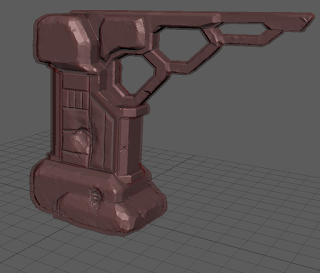Because I only need small details on the normal map I don't need a high poly mesh however what I do need is a program that will let me paint on normal information onto the mesh in 3D. Because the normal I have is too flat it is almost impossible to tell where the details are. Quixel also doesn't seem to let me do this, even though the initial tutorial for the suite displays the exact thing I want. As soon as I load up the mesh 3DO makes it exceptionally blurry and refuses to bring up the 3D painting mode which the suite definitely has.
Instead I got the Substance painter 30 day free trial and surprisingly it worked immediately. The program is excellent and let me easily draw normals straight onto the mesh. All I wanted in the normal was welding marks, scratches, some height texture and a few indentations. Once I got to grips with the controls it was fairly easy. The only thing I didn't work out how to do was place normal shapes on the mesh, I had to draw out and polygon-like shapes or tap using a shaped alpha.
Then I could go straight into painting. Substance has bunch of pre-made materials to use, most of them metal based, many with normal, height and roughness maps already set to them. I used fill layers with masks to create the textures. In Substance all the maps are combined and then exported separately so you can see how it would look finished while you are working on it.
























